📢 Should India Strengthen Laws to Prevent Caste-Based Violence?
🌐 Group Discussion Analysis Guide
🔍 Introduction to the Topic
Opening Context: Caste-based violence remains one of the most significant social issues in India, deeply rooted in history and entrenched in systemic inequalities. Despite various legal safeguards, incidents of such violence continue to highlight the gaps in enforcement and societal challenges.
Topic Background: Caste-based violence refers to discrimination, oppression, and atrocities inflicted based on caste hierarchies. Although the Indian Constitution abolished untouchability and introduced laws like the Scheduled Castes and Scheduled Tribes (Prevention of Atrocities) Act, 1989, there is a growing call for strengthening these provisions to ensure justice and equity.
📊 Quick Facts and Key Statistics
- 📈 Crime Rate Increase: Crimes against Scheduled Castes (SCs) rose by 7.8% in 2023 (NCRB).
- ⚖️ Legal Cases Pending: Over 70% of caste-related cases remain unresolved in lower courts (2022 data).
- 📚 Awareness Gap: Only 45% of SC/ST communities are aware of their legal rights (NGO reports).
- 🌍 Global Parallels: India ranks 101 out of 146 countries on the Social Inclusion Index (2023).
🤝 Stakeholders and Their Roles
- Government: Drafting and enforcing stricter legislation, conducting awareness campaigns, and reforming the judiciary.
- Civil Society: Advocating for marginalized groups and conducting grassroots programs to educate communities about rights.
- Judiciary: Ensuring timely justice by reducing case backlogs.
- Citizens: Changing societal attitudes through awareness and dialogue.
🎯 Achievements and Challenges
✅ Achievements
- 📜 Legislative Framework: Laws like the SC/ST Act and affirmative actions.
- 📈 Increased Reporting: Improved mechanisms for registering complaints.
- ⚖️ Judicial Support: Landmark judgments reinforcing the rights of marginalized communities.
⚠️ Challenges
- ❌ Underreporting: Fear of retaliation prevents victims from reporting crimes.
- ⏳ Judicial Delays: Long trial periods discourage victims from pursuing cases.
- 🛑 Social Stigma: Persistent caste-based biases affect justice delivery.
🌍 Global Comparisons
- 🇿🇦 South Africa’s Anti-Apartheid Model: Focused on inclusive policies and public reparations.
- 🇺🇸 US Civil Rights Movement: Showcased the importance of grassroots activism.
📚 Case Studies
- 🌾 Dalit Movement in Tamil Nadu: Effective grassroots organization addressing atrocities.
- 📖 Bhim Army: Mobilized for caste equality through education and protests.
🛠️ Structured Arguments for Discussion
- Supporting Stance: “Strengthening laws can ensure swifter justice and act as a deterrent against caste-based violence.”
- Opposing Stance: “Strong laws alone cannot resolve caste issues without societal change and grassroots efforts.”
- Balanced Perspective: “While stronger laws are essential, they must be complemented with education, awareness, and reformative measures.”
🚀 Effective Discussion Approaches
- Opening Approaches:
- 📊 Start with a statistic about rising caste-related crimes to highlight urgency.
- 📜 Reference a notable case study like the Hathras incident to set the context.
- Counter-Argument Handling: Rebut fears of over-legislation by emphasizing accountability and use international success stories to support progressive legal frameworks.
📈 Strategic Analysis of Strengths and Weaknesses
- 💪 Strengths: Strong constitutional base, proactive judiciary.
- 💔 Weaknesses: Social resistance, enforcement gaps.
- 🌟 Opportunities: Empower marginalized communities, global advocacy.
- ⚠️ Threats: Political interference, backlash from dominant groups.
🔗 Connecting with B-School Applications
- Real-World Applications: Link the topic to corporate social responsibility (CSR) and diversity initiatives.
- Sample Interview Questions:
- 📌 “How can B-schools promote caste inclusion in leadership?”
- 📌 “Discuss the role of education in combating caste discrimination.”
- Insights for Students:
- 🌟 Engage with diversity as a core management principle.
- 📊 Leverage data analysis to study social inequalities for academic projects.


